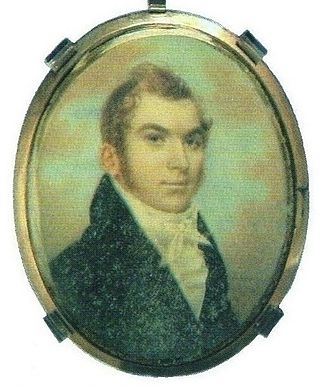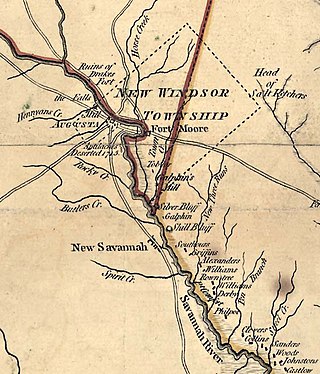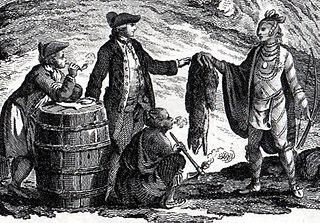
The Muscogee, also known as the Mvskoke, Muscogee Creek or just Creek, and the Muscogee Creek Confederacy, are a group of related Indigenous peoples of the Southeastern Woodlands in the United States. Their historical homelands are in what now comprises southern Tennessee, much of Alabama, western Georgia and parts of northern Florida.

The Creek War, was a regional conflict between opposing Native American factions, European powers, and the United States during the early 19th century. The Creek War began as a conflict within the tribes of the Muscogee, but the United States quickly became involved. British traders and Spanish colonial officials in Florida supplied the Red Sticks with weapons and equipment due to their shared interest in preventing the expansion of the United States into regions under their control.

The fur trade is a worldwide industry dealing in the acquisition and sale of animal fur. Since the establishment of a world fur market in the early modern period, furs of boreal, polar and cold temperate mammalian animals have been the most valued. Historically the trade stimulated the exploration and colonization of Siberia, northern North America, and the South Shetland and South Sandwich Islands.

Ocmulgee Mounds National Historical Park in Macon, Georgia, United States preserves traces of over ten millennia of culture from the Native Americans of the Southeastern Woodlands. Its chief remains are major earthworks built before 1000 CE by the South Appalachian Mississippian culture These include the Great Temple and other ceremonial mounds, a burial mound, and defensive trenches. They represented highly skilled engineering techniques and soil knowledge, and the organization of many laborers. The site has evidence of "12,000 years of continuous human habitation." The 3,336-acre (13.50 km2) park is located on the east bank of the Ocmulgee River. Macon, Georgia developed around the site after the United States built Fort Benjamin Hawkins nearby in 1806 to support trading with Native Americans.

Alexander McGillivray, also known as Hoboi-Hili-Miko, was a Muscogee (Creek) leader. The son of a Muscogee mother and a Scottish father, he was literate and educated, and understood the "white" European world and merchandise trading well. These gave him prestige, especially with European Americans, who were glad to finally find a Creek leader they could talk to and deal with. He used his role as link between the two worlds to his advantage, not always fairly, and became the richest Creek of his time.

Simon McTavish, of Montreal was a Scottish-born fur trader and the chief founding partner of the North West Company. He was a member of the Beaver Club and was known as the Marquis for his pre-eminent position in the fur trade and his refined style of living.

William Weatherford, also known after his death as Red Eagle, was a Creek chief of the Upper Creek towns who led many of the Red Sticks actions in the Creek War (1813–1814) against Lower Creek towns and against allied forces of the United States.
Lachlan McGillivray was a prosperous fur trader and planter in colonial Georgia with interests that extended from Savannah to what is now central Alabama. He was the father of Alexander McGillivray and the great-uncle of William McIntosh and William Weatherford, three of the most powerful and historically important Native American chiefs among the Creek of the Southeast.

Scottish colonization of the Americas comprised a number of failed or abandoned Scottish settlements in North America; a colony at Darien on the Isthmus of Panama; and a number of wholly or largely Scottish settlements made after the Acts of Union 1707, and those made by the enforced resettlement after the Battle of Culloden and the Highland Clearances.
The deerskin trade between Colonial Americans, Europeans, and Native Americans was an important trading relationship between Europeans and Native Americans, particularly in the southeastern colonies, engaging the Catawba, Shawnee, Cherokee, Muscogee, Choctaw, and Chickasaw peoples. It began in the 1680s due to fashion changes in Europe and boomed in the 1800s when the beaver trade decline. It was a part of the fur trade, but less known since deer skins were not as valuable as furs from the north. Cherokee mainly traded their deer skins to the English, while the Shawnee traded deer skins to both the French and English colonies prior to 1760.

Savannah Town, South Carolina is a defunct settlement that was located in the colonial years on the Savannah River below the Fall Line in present-day Aiken County. In the 1670s the Westo had a village here, but they were displaced by the Savannah in a trade war, and it became known by 1685 as Savannah Town. The English colony had traders who did a lucrative business in dressed skins with the Savannah Shawnee. Fortified as a frontier post, the settlement developed and ferry service was established across the river. The town was gradually overtaken by its competitor of Augusta, Georgia, established in 1735 five miles upriver and closer to Indian settlements. Traders here intercepted commerce, sending it to their port of Savannah on the coast. By 1740 Savannah Town was declining, and by 1765 the village was abandoned and the fort closed.
Henry Woodward, was a Barbados-born merchant and colonist who was one of the first white settlers in the Carolinas. He established relationships with many Native American Tribes in the American southeast. He initiated trade, primarily in deerskins and slaves, with many Indian towns and tribes.

Panton, Leslie & Company was a company of Scottish merchants active in trading in the Bahamas and with the Native Americans of what is now the Southeastern United States during the late 18th and early 19th centuries.
The Fur Trade in Canada: An Introduction to Canadian Economic History is a book written by Harold Innis covering the fur trade era in Canada from the early 16th century to the 1920s. First published in 1930, it comprehensively documents the history of fur trading while extending Innis's analysis of the economic and social implications of Canada's reliance on staple products. The book focuses on the far-reaching effects of new techniques and technologies in the contact between European and Indigenous civilizations and shows how co-operation and rivalries among French, English and Indigenous peoples shaped the history of the northern half of North America. Finally, the book tries to show how Canada emerged as a nation with boundaries largely determined by the fur trade. Canada, Innis argues, "emerged not in spite of geography, but because of it."

The North American fur trade is the (typically) historical commercial trade of furs and other goods in North America, predominantly in the eastern provinces of Canada and the northeastern American colonies. The trade was initiated mainly through French, Dutch and English settlers and explorers in collaboration with various First Nations tribes of the region, such as the Wyandot-Huron and the Iroquois; ultimately, the fur trade's financial and cultural benefits would see the operation quickly expanding coast-to-coast and into more of the continental United States and Alaska.
John Gordon was a Loyalist British merchant and trader of Scottish origin who lived in South Carolina for many years. He settled in Charles Town about 1760, and from 1759 to 1773 he was a major exporter of deerskins supplied by Native American hunters. Gordon also participated in the transatlantic slave trade but was not a major importer of captive Africans.

Native Americans living in the American Southeast were enslaved through warfare and purchased by European colonists in North America throughout the 17th, 18th, and 19th centuries, as well as held in captivity through Spanish-organized forced labor systems in Florida. Emerging British colonies in Virginia, Carolina, and Georgia imported Native Americans and incorporated them into chattel slavery systems, where they intermixed with slaves of African descent, who would eventually come to outnumber them. The settlers' demand for slaves affected communities as far west as present-day Illinois and the Mississippi River and as far south as the Gulf Coast. European settlers exported tens of thousands of enslaved Native Americans outside the region to New England and the Caribbean.
William Panton was the head of a group of five Scottish merchants who in 1783 founded the powerful and influential trading firm of Panton, Leslie & Company at St. Augustine, then the capital of British East Florida. They formed a partnership to trade with the Indians of Florida and the Spanish borderlands on the southern frontier of the British colonies. By 1795 the company had established a monopoly on trade with the Indian tribes of what is now the southeastern United States, sanctioned by successive governors of Spanish Florida.
Sophia Durant was a Koasati Native American plantation owner, who served as the speaker, interpreter, and translator for her brother, Alexander McGillivray, a leader in the Muscogee Confederacy.

Fort Okfuskee was the name of two separate forts built by Great Britain in what is now Tallapoosa County, Alabama. The first fort was built to ensure British trade with the Creek Indians after the French constructed Fort Toulouse. The fort was abandoned a little over a decade after construction after facing difficulties in being supplied. A second Fort Okfuskee was built a year later, but was abandoned in less than a year due to lack of colonial support.













